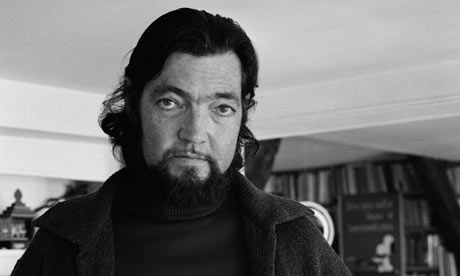 |
| Julio Cortázar |
A brief survery of the short story part 22: Julio Cortázar
BIOGRAPHY
Cortázar's vividly experimental, uncanny tales are among the best work of 'el boom' in Latin American writing

Julio Cortázar at home in France in 1974. Photograph: Sophie Bassouls/Sygma/Corbis
Since his death in 1984, Argentine novelist, poet and short story writerJulio Cortázar's reputation in the English-speaking world has fluctuated, the trend heading more towards a waning than a waxing. Known-of rather than widely read, some recognition is still afforded him as the author of the 1963 novel Hopscotch, and also of the excellent short story from which Blowup, Michelangelo Antonioni's iconic depiction of Swinging 60s London, was liberally adapted.
Hopscotch's reputation comes partly from its experimental form: a three-part novel comprising numbered paragraphs, it can be read according to an alternative, non-linear pattern in which the final section becomes a metatextual commentary on the first two. More importantly, Hopscotch was influential in terms of the shifting registers and jazz-influenced riffs of its prose. A key text of the so-called Latin American "boom", Mario Vargas Llosa and Carlos Fuentes have both credited it with modernising Latin-American literary language, while Gabriel García Márquez paid homage by alluding to it in One Hundred Years of Solitude.
Yet it is Cortázar's short stories that represent, in the words of Argentine critic Jaime Alazraki, the "vertebral column" running through his work. Those written in the 1950s and 1960s offer the strongest case for their author's greatness. A fecund mixture of surrealism, symbolism, nouveau roman experimentation and Borgesian fantasy, Cortázar enthusiastically seeds his realistic settings – for the most part split between Buenos Aires and Paris – with impossible invasions of the fantastical and supernatural. The effect is often a refined philosophical take on the "uncanny tales" strand of speculative fiction.
Cortázar left Argentina for Paris in 1952, where he remained for the rest of his life, taking work as a Unesco translator. He translated Poe, whose aura pervades House Taken Over (1944), first published in Borges's magazine Los anales de Buenos Aires. It describes a brother and sister living a self-contained life in their large family home in Buenos Aires. When unnamed others infiltrate part of it, the brother and sister seal it off and live in the remainder. The identity of these others remains tantalisingly obscure, brother merely telling sister, "'I had to shut the door to the passage. They've taken over the back part.'" Later, further noises signal that the entire house has been breached, and the owners flee into the night after locking up the house to protect burglars from whatever "it" might be that has taken residence.
Typically of Cortázar, and anticipating the magical realist style that would brand him and his fellow "boom" authors of the 1960s, fantastical happenings are mostly accepted by his characters with the same amount of surprise the opening of a beer might garner in Bukowski. Another defining trait is the prominence of ambiguity. Depending on its readers' theories, House Taken Over might be horror, social satire, political commentary or psychological thriller.
House Taken Over featured in Cortázar's first collection, Bestiary (1951), the title story of which augments ambiguity with surrealism. Isabel spends the summer at her Aunt Rema's house, a normal bourgeois residence but for one fact: a large tiger roams the premises, with servants and family members constantly reporting where it is and which rooms or parts of the garden must currently be avoided. The strange, resentful and implicitly violent atmosphere between Isabel's cousins adds a further layer of unease.
Identity proves to be Cortázar's greatest fascination. His characters frequently lose or swap their identity, or suffer some kind of possession. In Axolotl, a man at an aquarium appears to become one of the amphibians he is viewing. The Distances sees a rich woman hug a beggar on a Budapest bridge, only to watch herself walk away and realise she is now trapped in another body. A Yellow Flower describes a man murdering a teenage boy whom he is convinced is his own precipitate reincarnation. Perhaps most audacious among these is the profoundly chilling Secret Weapons (1959), in which a post-war Parisian man appears to become the executed German who raped the girl he is courting several years ago, during the Occupation. With its building atmosphere of terrible violence and small, significant details obsessively recycling and developing throughout the text, it's extremely close in style to David Peace.
You don't have to endorse the claim Cortázar made shortly before his death that his short stories were the best things ever to have been written in Spanish to appreciate him as a remarkable and versatile talent. His most appealing quality is the apprehensive oddness with which he infuses reality. Even one of his "straighter" stories, the Beat-influenced The Pursuer (1959), is richly strange, its narrative jumps and extended conversations between death-stalked Johnny (based on Charlie Parker) and the jazz critic Bruno adopting the rhythms of the form with which the story is concerned. Here, too, identities shift and break apart ("I am not I," Johnny says feverishly) while through Bruno, Cortázar makes the admission: "I prefer the words to the reality that I'm trying to describe." If you could do what he could with words, why wouldn't you?
DE OTROS MUNDOS
Bestiario
Otros cuentos
MESTER DE BREVERÍA
FICCIONES
PESSOA
DRAGON
BIOGRAPHIES
A brief survey of the short story
001 Anton Chekhov
002 HP Lovecraft
003 Mavis Gallant
004 Ryunosuke Akutagawa
005 Raymond Carver
006 Julian Maclaren-Ross
007 Etgar Keret
008 Robert Walser
009 VS Pritchett
010 Grace Paley
011 Katherine Mansfield
012 Heinrich von Kleist
013 Franz Kafka
014 MR James
015 F Scott Fitzgerald
016 Donald Barthelme
017 Jane Bowles
018 Stefan Zweig
019 Ray Badbury
020 Nikolai Gogol



No comments:
Post a Comment